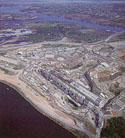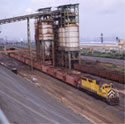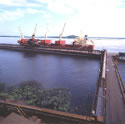|
Sections |
Our Company |
Enviromental
Protection |
|
|
Orinoco Iron is the largest
merchant Hot Briquette Iron (HBI) producer in the Americas.
The plant uses FINMET® technology, and is able to produce
2.2 million metric tons of HBI per year. The company is
present in four continents and its export experience began
in late 1970's.
Our mission is to actively contribute to maintain and
increase our clients' performance and the quality of their
products through the reliable supply of metallic iron units,
exceeding our clients' requirements and according to their
steelmaking processes. We strive towards higher
profitability that will strengthen our viability, allowing
us to grow, increase our personnel's welfare, and yield an
attractive return to our shareholders. |
In all of our operations,
Orinoco Iron acts in a socially responsible manner, while
the operations stand out due to their advanced technology
and by being in harmony with the environment. |
|
Facilities
and Operations |
In Our Community Orinoco Iron
aims to maintain mutually beneficial relationships between
the organization and the community in which its operations
are located. We have generated close ties with community
leaders and citizens in Puerto Ordaz, and Caracas,
Venezuela, and these cities have benefited by our presence
as well.
|
Orinoco Iron Plant
Finmet® Process 2,200,000 MT/Year |
 Orinoco
Iron uses a fluid bed iron ore fines reduction
process to produce hot molded briquettes. The Finmet®
process is based upon the reduction of iron ore to
metallic iron at high temperature and pressure using
reducing gases produced from reforming. The reducing
gas utilized has a high content of hydrogen. Orinoco
Iron uses a fluid bed iron ore fines reduction
process to produce hot molded briquettes. The Finmet®
process is based upon the reduction of iron ore to
metallic iron at high temperature and pressure using
reducing gases produced from reforming. The reducing
gas utilized has a high content of hydrogen.
The heart of the process is a series of four
fluidized bed reactors to convert iron ore fines (12
mm) to HBI. The fines are first preheated in the
preheat reactor by the combustion of natural gas in
a fluidized bed under non-reducing conditions.
Now at a temperature of 750°C, the fines flow by
gravity to the first of three reducing reactors, and
pass successively down through the other two. The
iron ore is reduced by contact with the reducing
gas, and reaches a metalization of 92-93% in the
final reactor. Here carbon is formed on the reduced
iron ore in the form of iron carbide.
Once the reduction process is completed, the hot
iron is transferred to the briquetting machines,
where it is compacted between counter-revolving
rollers into strings of briquettes. The strings are
separated into individual briquettes. The briquettes
are passivated and cooled, and then are stored in
outdoor storage piles. The briquettes produced in
this process are very inert and exhibit little re-oxidation
tendency.
An integral part of the process is the quality
control, which is applied at each step and thereby
ensures that the final product quality meets Orinoco
Iron's standards. |
| |
|
Raw Materials and
Utility Sources |
Iron Ore
 Iron
ore is mined and sold in Venezuela exclusively by
CVG FMO, whose mines are located in the Guayana
region. The iron ore reserves of CVG FMO are
estimated to be around 4.2 billion tons of proven
reserves and 14.7 billion tons of total reserves,
including estimates for probable and possible
deposits. Venezuela can supply its expected
metallics demand for more than a century based upon
present demand and proven reserves. Iron
ore is mined and sold in Venezuela exclusively by
CVG FMO, whose mines are located in the Guayana
region. The iron ore reserves of CVG FMO are
estimated to be around 4.2 billion tons of proven
reserves and 14.7 billion tons of total reserves,
including estimates for probable and possible
deposits. Venezuela can supply its expected
metallics demand for more than a century based upon
present demand and proven reserves.
The proven reserves for mines with at least 64% iron
on a dry basis is 1.7 billion tons. This type of ore
is classified as shipping grade, and as such it can
be used directly from the mine for steelmaking or
direct reduction. There are another 2.5 billion tons
of proven ore reserves with 60 to 63% iron. This ore
would require a minimal amount of upgrading in order
to be used in steelmaking. By comparison, most US
ores have less than 50% iron and have to be
beneficiated so that iron ore can be used for
steelmaking.
In Venezuela, as in many mining regions in the rest
of the world, the major part of the ore mined is in
the form of fines under 1/2" in size.
Utility Sources
Natural Gas
Natural gas for the Project is provided by Pdvsa
Gas, the sole supplier in the region. Currently, the
gas is produced at wells in the El Tigre area and is
transported by pipeline to a gas liquid extraction
plant at Jose, on the coast, and then sent by
pipeline to the Orinoco Iron Plant.
Venezuela has proven natural gas reserves of 148
trillion cubic feet (Tcf), the second largest in the
Western Hemisphere (behind the United States). In
addition, new discoveries far exceed increases in
consumption. Consumption in the Puerto Ordaz area is
in the order of 3.4 billion m3 per year, 12% of
total production.
Electrical Power
Electricity is provided by Edelca, which owns and
operates all the hydroelectric power supply of the
Guayana region. The electricity is supplied by one
of the largest and most reliable hydroelectric
networks in the world, as its power generation
capacity is not vulnerable to adverse changes in
rainfall conditions. The Dams -Guri, Macagua I,
Macagua II, and Macagua III- provide a combined
generating capacity of over 13,500 MW. This will be
increased by the construction of new hydroelectric
dams in the future. The region's total hydroelectric
capacity is forecasted to be over 18,000 MW by 2010.
Water
Industrial water is supplied from the Caroní River,
which has a maximum flow over 10,000 m3/sec. The
Orinoco Iron Plant uses 0.2 m3/sec. |
| |
|
Facilities /
Supporting Infraestructure |
Rail Transportation
 There
is an existing rail line adjacent to the Orinoco
Iron Plant site which connects the Matanzas
Industrial Zone to the CVG FMO ore processing
facilities at Puerto Ordaz and Palúa. There
is an existing rail line adjacent to the Orinoco
Iron Plant site which connects the Matanzas
Industrial Zone to the CVG FMO ore processing
facilities at Puerto Ordaz and Palúa.
The ore required by Orinoco Iron is delivered by
rail car to an unloading station located at the
Plant. HBI product from the Plant is transported by
conveyor belts to metal storage hoppers located over
the rail spur at the rail receiving station inside
the Plant site. HBI is an inert material and can be
safely stored in uncovered piles or in hoppers. The
hoppers will discharge the HBI directly into the
rail cars, which deliver the HBI to the shipping
port.
Capacity of CVG FMO rail line 32 million tpa
Roads
The Guayana region has one of the best road networks
in Venezuela. The Matanzas Industrial Zone has a
modern road network which connects it with
neighboring towns. A well maintained four lane
highway connects it to both Puerto Ordaz and Ciudad
Bolívar. A six lane road connects Matanzas to San
Felix, where many of the workers in the heavy
industrial plants live.
Orinoco River
The Orinoco River has an estimated maximum shipping
capacity of 100 million tpa, or more than five times
its present traffic. Vessels of up to 80,000 DWT can
load during the period when the Orinoco River draft
is high (during May-November) and vessels of around
40-50,000 DWT can make the passage to the Atlantic
during the dry season. The draft in the low season
is 28-30 feet, while in the high season is 32-38
feet. Most HBI cargoes are being transported in
25-40.000 ton lots.
Port Facilities
 The
Palúa facility is located on the mile 184 of the
Orinoco River. HBI from the Orinoco Iron Plant is
exported from the Palúa facility at San Felix. The
Palúa dock has 276.6 meters in length and can berth
one vessel. Palúa's ship loading capacity is 1,100
tph for HBI. At present HBI is transported to Palúa
and stored at a 150,000 tons store-yard. The
Palúa facility is located on the mile 184 of the
Orinoco River. HBI from the Orinoco Iron Plant is
exported from the Palúa facility at San Felix. The
Palúa dock has 276.6 meters in length and can berth
one vessel. Palúa's ship loading capacity is 1,100
tph for HBI. At present HBI is transported to Palúa
and stored at a 150,000 tons store-yard.
The HBI is transported from the plant to the port by
rail cars, and stored in piles, then the product is
loaded by front end loaders onto a mechanized system
which sends it into the ships.
These installations are designed in conformity with
the concept of "soft loading", in order to optimize
the degradation of the product, which improve the
material handling. |
|
|
|